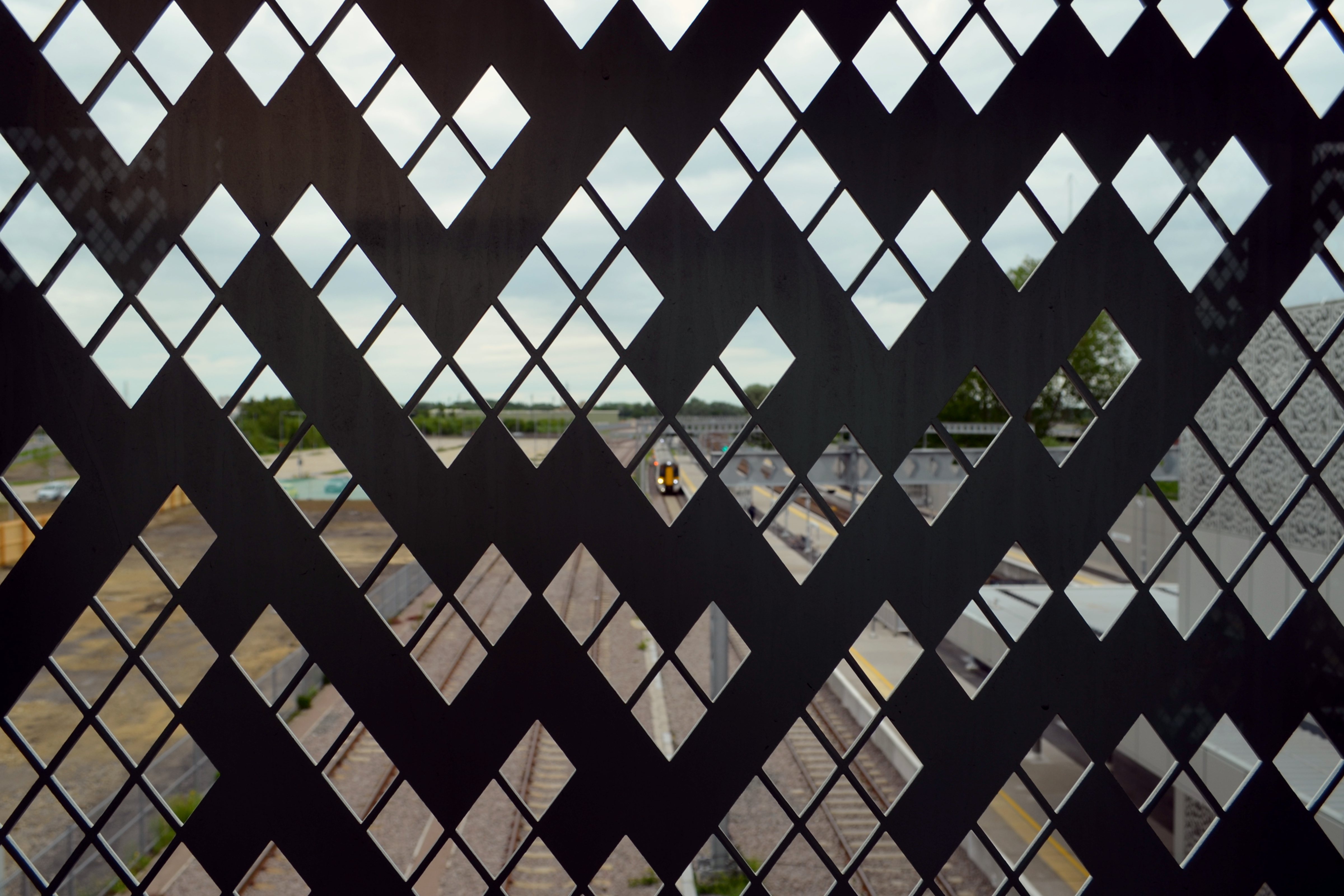Rule 30 on:
[Wikipedia]
[Google]
[Amazon]
 Rule 30 is an elementary cellular automaton introduced by
Rule 30 is an elementary cellular automaton introduced by


Rule 30 cellular automaton
Here, the vertical axis represents time and any horizontal cross-section of the image represents the state of all the cells in the array at a specific point in the pattern's evolution. Several motifs are present in this structure, such as the frequent appearance of white triangles and a well-defined striped pattern on the left side; however the structure as a whole has no discernible pattern. The number of black cells at generation is given by the sequence
:1, 3, 3, 6, 4, 9, 5, 12, 7, 12, 11, 14, 12, 19, 13, 22, 15, 19, ...
and is approximately .
 The
The
#include
#include
int main()
This program produces the following output:
Cryptography with Cellular Automata
', CRYPTO'85.
Rule 30 in Wolfram's atlas of cellular automata
Recipe 32 at David Griffeath's Primordial Soup Kitchen.
Repeating Rule 30 patterns
A list of patterns that, when repeated to fill the cells of a Rule 30 automaton, repeat themselves after finitely many time steps. Frans Faase, 2003. Archived from th
on 2013-08-08
Basic introduction to the pattern of Rule 30 from the perspective of a LOGO software expert Olivier Schmidt-Chevalier.
Stephen Wolfram speaks about computing a theory of everything where he talks about rule 30 among other things. {{DEFAULTSORT:Rule 030 Cellular automaton rules 1983 introductions Wolfram code
Stephen Wolfram
Stephen Wolfram ( ; born 29 August 1959) is a British-American computer scientist, physicist, and businessman. He is known for his work in computer algebra and theoretical physics. In 2012, he was named a fellow of the American Mathematical So ...
in 1983. Using Wolfram's classification scheme, Rule 30 is a Class III rule, displaying aperiodic, chaotic behaviour.
This rule is of particular interest because it produces complex, seemingly random patterns from simple, well-defined rules. Because of this, Wolfram believes that Rule 30, and cellular automata in general, are the key to understanding how simple rules produce complex structures and behaviour in nature. For instance, a pattern resembling Rule 30 appears on the shell of the widespread cone snail species '' Conus textile''. Rule 30 has also been used as a random number generator
Random number generation is a process by which, often by means of a random number generator (RNG), a sequence of numbers or symbols is generated that cannot be reasonably predicted better than by random chance. This means that the particular ou ...
in Mathematica
Wolfram (previously known as Mathematica and Wolfram Mathematica) is a software system with built-in libraries for several areas of technical computing that allows machine learning, statistics, symbolic computation, data manipulation, network ...
, and has also been proposed as a possible stream cipher
stream cipher is a symmetric key cipher where plaintext digits are combined with a pseudorandom cipher digit stream ( keystream). In a stream cipher, each plaintext digit is encrypted one at a time with the corresponding digit of the keystrea ...
for use in cryptography
Cryptography, or cryptology (from "hidden, secret"; and ''graphein'', "to write", or ''-logy, -logia'', "study", respectively), is the practice and study of techniques for secure communication in the presence of Adversary (cryptography), ...
.
Rule 30 is so named because 30 is the smallest Wolfram code which describes its rule set (as described below). The mirror image, complement, and mirror complement of Rule 30 have Wolfram codes 86, 135, and 149, respectively.
Rule set
In all of Wolfram's elementary cellular automata, an infinite one-dimensional array of cellular automaton cells with only two states is considered, with each cell in some initial state. At discrete time intervals, every cell spontaneously changes state based on its current state and the state of its two neighbors. For Rule 30, the rule set which governs the next state of the automaton is: If the left, center, and right cells are denoted ''(p,q,r)'' then the corresponding formula for the next state of the center cell can be expressed as ''p xor (q or r)''. It is called Rule 30 because in binary, ''000111102'' = 30. The following diagram shows the pattern created, with cells colored based on the previous state of their neighborhood. Darker colors represent "1" and lighter colors represent "0". Time increases down the vertical axis.Structure and properties
The following pattern emerges from an initial state in which a single cell with state 1 (shown as black) is surrounded by cells with state 0 (white).
Rule 30 cellular automaton
Chaos
Rule 30 meets rigorous definitions of chaos proposed by Devaney and Knudson. In particular, according to Devaney's criteria, Rule 30 displays sensitive dependence on initial conditions (two initial configurations that differ only in a small number of cells rapidly diverge), its periodic configurations are dense in the space of all configurations, according to the Cantor topology on the space of configurations (there is a periodic configuration with any finite pattern of cells), and it is mixing (for any two finite patterns of cells, there is a configuration containing one pattern that eventually leads to a configuration containing the other pattern). According to Knudson's criteria, it displays sensitive dependence and there is a dense orbit (an initial configuration that eventually displays any finite pattern of cells). Both of these characterizations of the rule's chaotic behavior follow from a simpler and easy to verify property of Rule 30: it is ''left permutative'', meaning that if two configurations and differ in the state of a single cell at position , then after a single step the new configurations will differ at cell .Applications
Random number generation
As is apparent from the image above, Rule 30 generates seeming randomness despite the lack of anything that could reasonably be considered random input. Stephen Wolfram proposed using its center column as apseudorandom number generator
A pseudorandom number generator (PRNG), also known as a deterministic random bit generator (DRBG), is an algorithm for generating a sequence of numbers whose properties approximate the properties of sequences of random number generation, random n ...
(PRNG); it passes many standard tests for randomness, and Wolfram previously used this rule in the Mathematica product for creating random integers.
Sipper and Tomassini have shown that as a random number generator Rule 30 exhibits poor behavior on a chi squared test when applied to all the rule columns as compared to other cellular automaton-based generators. The authors also expressed their concern that "The relatively low results obtained by the rule 30 CA may be due to the fact that we considered N random sequences generated in parallel, rather than the single one considered by Wolfram."
Decoration
 The
The Cambridge North railway station
Cambridge North railway station is a railway station located in northern Cambridge, immediately adjacent to the suburb of Chesterton, Cambridge, Chesterton, close to Cambridge Science Park. The station is on the Fen Line, which runs from Cambr ...
is decorated with architectural panels displaying the evolution of Rule 30 (or equivalently under black-white reversal, Rule 135). The design was described by its architect as inspired by Conway's Game of Life
The Game of Life, also known as Conway's Game of Life or simply Life, is a cellular automaton devised by the British mathematician John Horton Conway in 1970. It is a zero-player game, meaning that its evolution is determined by its initial ...
, a different cellular automaton studied by Cambridge mathematician John Horton Conway
John Horton Conway (26 December 1937 – 11 April 2020) was an English mathematician. He was active in the theory of finite groups, knot theory, number theory, combinatorial game theory and coding theory. He also made contributions to many b ...
, but is not actually based on Life.
Programming
The state update can be done quickly bybitwise operation
In computer programming, a bitwise operation operates on a bit string, a bit array or a binary numeral (considered as a bit string) at the level of its individual bits. It is a fast and simple action, basic to the higher-level arithmetic operatio ...
s, if the cell values are represented by the bits within one (or more) computer words. Here shown in C++:
................................O............................... ...............................OOO.............................. ..............................OO..O............................. .............................OO.OOOO............................ ............................OO..O...O........................... ...........................OO.OOOO.OOO.......................... ..........................OO..O....O..O......................... .........................OO.OOOO..OOOOOO........................ ........................OO..O...OOO.....O....................... .......................OO.OOOO.OO..O...OOO...................... ......................OO..O....O.OOOO.OO..O..................... .....................OO.OOOO..OO.O....O.OOOO.................... ....................OO..O...OOO..OO..OO.O...O................... ...................OO.OOOO.OO..OOO.OOO..OO.OOO.................. ..................OO..O....O.OOO...O..OOO..O..O................. .................OO.OOOO..OO.O..O.OOOOO..OOOOOOO................ ................OO..O...OOO..OOOO.O....OOO......O............... ...............OO.OOOO.OO..OOO....OO..OO..O....OOO.............. ..............OO..O....O.OOO..O..OO.OOO.OOOO..OO..O............. .............OO.OOOO..OO.O..OOOOOO..O...O...OOO.OOOO............ ............OO..O...OOO..OOOO.....OOOO.OOO.OO...O...O........... ...........OO.OOOO.OO..OOO...O...OO....O...O.O.OOO.OOO.......... ..........OO..O....O.OOO..O.OOO.OO.O..OOO.OO.O.O...O..O......... .........OO.OOOO..OO.O..OOO.O...O..OOOO...O..O.OO.OOOOOO........ ........OO..O...OOO..OOOO...OO.OOOOO...O.OOOOO.O..O.....O....... .......OO.OOOO.OO..OOO...O.OO..O....O.OO.O.....OOOOO...OOO...... ......OO..O....O.OOO..O.OO.O.OOOO..OO.O..OO...OO....O.OO..O..... .....OO.OOOO..OO.O..OOO.O..O.O...OOO..OOOO.O.OO.O..OO.O.OOOO.... ....OO..O...OOO..OOOO...OOOO.OO.OO..OOO....O.O..OOOO..O.O...O... ...OO.OOOO.OO..OOO...O.OO....O..O.OOO..O..OO.OOOO...OOO.OO.OOO.. ..OO..O....O.OOO..O.OO.O.O..OOOOO.O..OOOOOO..O...O.OO...O..O..O. .OO.OOOO..OO.O..OOO.O..O.OOOO.....OOOO.....OOOO.OO.O.O.OOOOOOOOO
See also
* Rule 90 * Rule 110 * Rule 184References
* Wolfram, Stephen, 1985,Cryptography with Cellular Automata
', CRYPTO'85.
External links
* *Rule 30 in Wolfram's atlas of cellular automata
Recipe 32 at David Griffeath's Primordial Soup Kitchen.
Repeating Rule 30 patterns
A list of patterns that, when repeated to fill the cells of a Rule 30 automaton, repeat themselves after finitely many time steps. Frans Faase, 2003. Archived from th
on 2013-08-08
Basic introduction to the pattern of Rule 30 from the perspective of a LOGO software expert Olivier Schmidt-Chevalier.
Stephen Wolfram speaks about computing a theory of everything where he talks about rule 30 among other things. {{DEFAULTSORT:Rule 030 Cellular automaton rules 1983 introductions Wolfram code